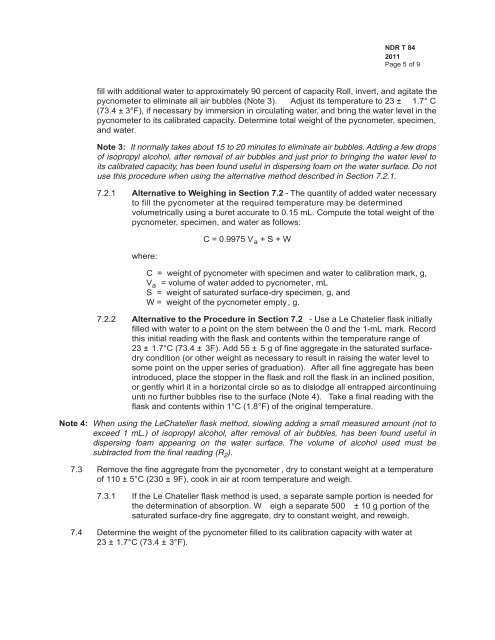specific gravity and absorption of fine aggregate - Nebraska ...
specific gravity and absorption of fine aggregate - Nebraska ...
specific gravity and absorption of fine aggregate - Nebraska ...
You also want an ePaper? Increase the reach of your titles
YUMPU automatically turns print PDFs into web optimized ePapers that Google loves.
NDR T 842011Page 5 <strong>of</strong> 9fill with additional water to approximately 90 percent <strong>of</strong> capacity. Roll, invert, <strong>and</strong> agitate thepycnometer to eliminate all air bubbles (Note 3). Adjust its temperature to 23 ± 1.7° C(73.4 ± 3°F), if necessary by immersion in circulating water, <strong>and</strong> bring the water level in thepycnometer to its calibrated capacity. Determine total weight <strong>of</strong> the pycnometer, specimen,<strong>and</strong> water.Note 3: It normally takes about 15 to 20 minutes to eliminate air bubbles. Adding a few drops<strong>of</strong> isopropyl alcohol, after removal <strong>of</strong> air bubbles <strong>and</strong> just prior to bringing the water level toits calibrated capacity, has been found useful in dispersing foam on the water surface. Do notuse this procedure when using the alternative method described in Section 7.2.1.7.2.1 Alternative to Weighing in Section 7.2 - The quantity <strong>of</strong> added water necessaryto fill the pycnometer at the required temperature may be determinedvolumetrically using a buret accurate to 0.15 mL. Compute the total weight <strong>of</strong> thepycnometer, specimen, <strong>and</strong> water as follows:where:C = 0.9975 V a + S + WC = weight <strong>of</strong> pycnometer with specimen <strong>and</strong> water to calibration mark, g,V a = volume <strong>of</strong> water added to pycnometer, mLS = weight <strong>of</strong> saturated surface-dry specimen, g, <strong>and</strong>W = weight <strong>of</strong> the pycnometer empty, g.7.2.2 Alternative to the Procedure in Section 7.2 - Use a Le Chatelier flask initiallyfilled with water to a point on the stem between the 0 <strong>and</strong> the 1-mL mark. Recordthis initial reading with the flask <strong>and</strong> contents within the temperature range <strong>of</strong>23 ± 1.7°C (73.4 ± 3F). Add 55 ± 5 g <strong>of</strong> <strong>fine</strong> <strong>aggregate</strong> in the saturated surfacedrycondition (or other weight as necessary to result in raising the water level tosome point on the upper series <strong>of</strong> graduation). After all <strong>fine</strong> <strong>aggregate</strong> has beenintroduced, place the stopper in the flask <strong>and</strong> roll the flask in an inclined position,or gently whirl it in a horizontal circle so as to dislodge all entrapped air , continuingunti no further bubbles rise to the surface (Note 4). Take a final reading with theflask <strong>and</strong> contents within 1°C (1.8°F) <strong>of</strong> the original temperature.Note 4: When using the LeChatelier flask method, slowling adding a small measured amount (not toexceed 1 mL.) <strong>of</strong> isopropyl alcohol, after removal <strong>of</strong> air bubbles, has been found useful indispersing foam appearing on the water surface. The volume <strong>of</strong> alcohol used must besubtracted from the final reading (R 2 ).7.3 Remove the <strong>fine</strong> <strong>aggregate</strong> from the pycnometer , dry to constant weight at a temperature<strong>of</strong> 110 ± 5°C (230 ± 9F), cook in air at room temperature <strong>and</strong> weigh.7.3.1 If the Le Chatelier flask method is used, a separate sample portion is needed forthe determination <strong>of</strong> <strong>absorption</strong>. W eigh a separate 500 ± 10 g portion <strong>of</strong> thesaturated surface-dry <strong>fine</strong> <strong>aggregate</strong>, dry to constant weight, <strong>and</strong> reweigh.7.4 Determine the weight <strong>of</strong> the pycnometer filled to its calibration capacity with water at23 ± 1.7°C (73.4 ± 3°F).
















